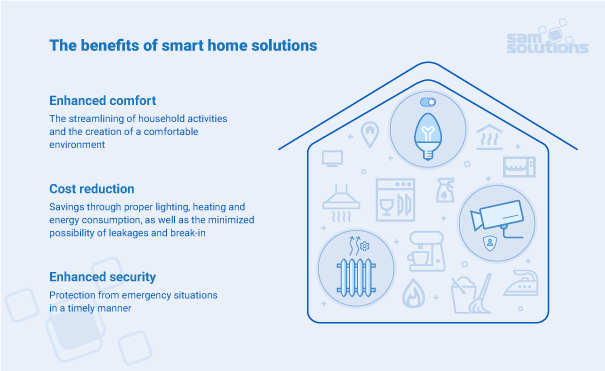The ever-growing use of smart devices has already influenced all aspects of human life and has triggered the emergence of the smart home. In this article, we will investigate why smart home providers should place the utmost importance on providing efficient mobile applications to manage their systems. To ensure maximum comprehension, we will illustrate it with two real-world business examples — SaM Solutions’ proprietary smart home system and a mobile app for a home automation platform that we created for our customer.
Make your services or business accessible at your clients’ fingertips with mobile app development from SaM Solutions.
What Is Smart Home and Why Is It Gaining Traction?
Smart home technology, aka home automation or domotics, integrates smart devices into comprehensive networks to enable their efficient collaboration and minimize human participation. Existing solutions embrace a wide range of technologies such as entertainment, security, utilities, lighting, energy management and more. Other sectors will soon come on board, while the revenue in the smart home market is predicted to amount to $153,017 million by 2023.
However, home automation demand a proper home automation mobile app to coordinate all system components and create an efficient infrastructure. Smart home app development helps address this requirement. To understand why systems of the type require proper mobile apps to control them, we will examine what makes up a smart house as exemplified by SaM Solutions’ proprietary application.
The Examples of Smart Home Systems
By making the most out of the Internet of Things, domotics has completely changed the way people go about their daily routines. So, we will investigate the capabilities of these solutions through the example of SaM Solutions’ smart home application that embraces multiple devices and systems of various types and performs the following tasks:
- The management of household and entertainment appliances. A coffee maker brews coffee by the time you wake up, an oven cooks dinner before a family returns home, and a vacuum cleans the house before guests come. Also, users can turn on lighting, TV and sound systems while they are away on vacation to disorient potential intruders.
- Energy consumption governance. A washing machine’s socket disconnects from the power network after the laundry is finished, so does that of a dishwasher after the device has finished its job.
- Temperature control. Thermostats adjust heating and air conditioning systems so that they maintain the required temperature.
- Lighting orchestration. Entryway lighting switches on before people come home, while the dimming control adjusts to outside light intensity.
- The locking and unlocking of doors and windows. Welcome guests can enter the house when owners are away, and windows and vent panes close when the weather breaks.
- The house owner and respective services get alerts in cases of a smoke condition, gas and CO leaks or a break-in.Naturally, the capabilities of solutions for smart houses are not limited to these examples. The beauty of these systems is that they allow users to create configurations and environments that perfectly fit their specific demands.
The Benefits of Smart Home Solutions
More and more users opt for smart home technologies. Why? They provide the following benefits:
- Enhanced comfort. Solutions help create a comfortable environment; they simplify many of the household activities such as cooking, cleaning, heating and more. Also, they help eliminate trifling processes that can be performed automatically, such as light switching on/off, shade lowering, window opening and more.
- Cost reduction. While the implementation of these solutions requires spending on purpose-oriented devices and related software and services, the savings down the road greatly outweigh the initial investment. Proper configuration of lighting, heating and energy consumption systems enables significant savings, not to mention the alarm system that helps prevent fire or water leakage damage or losses from a break-in.
- Enhanced security. Video-surveillance together with properly tuned signaling system protects from or helps timely address emergency situations, such as a break-in, fire, gas and water leaks.
Why Should Companies Opt for Mobile Smart Home Control Apps?
Modern home automation solutions are more than just software that allows cooking dinner by the specified time. Nowadays, these systems are responsible for many aspects of a user’s life, as they concern time management, well-being and even safety and privacy.
An efficient smart home environment goes hand-in-hand with a comprehensive application that manages the interaction of smart devices, cloud software, IoT gateways and other components of the home infrastructure. Here remote access is a prerequisite as it allows for managing devices via a smartphone, and it is what these solutions are about — the streamlining and simplifying of users’ lives.
While some solutions create large self-dependence home environments by uniting several systems and some of them even rely on Big Data algorithms in data processing, they still require user involvement.
Only users can select appropriate options that meet their specific requirements and preferences. Also, hardly anybody would like to leave their domotics solutions unattended, without proper monitoring and control. That is why smart home development companies complement their offerings with full-fledged control software.
The heavy use of connected smart devices encourages the focus on the producers of portables as the major consumer of smart home control applications. Depending on a number of purposes that these apps serve, they fall into the two types: single-purpose software and smart hubs.
Single-purpose applications. Control software that covers one specific area, such as Oral-B App that manages the vendor’s Bluetooth-based electrical toothbrushes. The software monitors tooth cleaning: it determines for how long users should do their teeth and to which areas they should pay special attention.
Smart hubs. Software that governs a variety of devices integrated into powerful aim-specific systems. For example, Apple Home application integrates a wide range of HomeKit-enabled accessories and manages lighting, heating, air conditioning, video surveillance, security and other systems. A user can issue commands both by telling Siri what to do or via 3D Touch that enables performing sophisticated tasks.
Smart hubs enable the most comfortable management of home systems, which is why this type of smart home control software is now on the rise. The most well-recognized solutions are those of the technology market leaders — Google Home, Samsung Smart Home, LG Smart ThinQ, Amazon Alexa, Philips Hue and Apple’s Home.
Developing a Robust Mobile Smart Home Control Application
Efficient mobile applications serve as home environment remote controllers that allow users to reach houses, configure and change required settings via the internet connection. That is why many companies seek a solution that controls appliances and systems efficiently and safely.
Let’s dive in key insights into the development of a home automation application based on our domain experience and expertise and industry best practices. Also, we will exemplify it by a mobile application created for a European provider of a cross-vendor smart home platform. The platform comprises various sensors and integrates devices from numerous manufacturers under the central interface.
Critical Features to Provide
Naturally, the range of features that home automation apps have vary with any specific case. However, any solution should possess the following critical features, regardless of its purpose and functionality:
- System-wide connectivity. Devices should communicate easily within the system for example, via the wireless connection; otherwise, they cannot execute instructions.
- The availability of multifold settings and configurations. These apps manage environments that include numerous device combinations, which is why they should provide extensive customization capabilities to meet the specific requirements of each individual user.
- The availability for all mobile operating systems and devices. Domotics software development companies should bring their solutions within the reach of the users of all mobile platforms, especially iOS and Android, and device types. As with our customer’s solution, we provided an iOS– and Android-friendly mobile app.
- Push notification capability. Notifications allow users to know about emergency situations as they occur.
- Powerful data visualization. Information visibility considerably adds to app usability and helps users make the most out of intelligent decision-making to more informed decisions. In our system, we rely it on Big Data and IoT Edge algorithms for better data parsing and analysis.
The Development Process
As with any software, a company should take standard steps from prototyping to implementation to build a smart home app.
Proper solution designing and prototyping is the key factor that helps companies successfully develop a smart house automation app. A company determines the software purpose, which influences the number and the variety of devices that application will manage, as well as its complexity.
While companies tend to equip their solutions with a myriad of features to win as many customers as possible, we recommend going easy on excess information and capabilities. Although users seem to benefit from lavish functionality, it may frighten them instead: very few have the desire and time to understand the overly sophisticated capabilities. As a result, they will fall back on less elaborate solutions provided by competitors.
This stage also determines the choice of hardware that the application uses. From the common user’s point of view, a vendor should not focus its solution on a specific appliance manufacturer and should provide the freedom of choice.
As to the solution’s UI and UX design, its user-friendliness is a prerequisite. Also, as with excessive capabilities, it should not be overcomplicated. Customers want these applications to streamline their lives, which is why a non-intuitive interface may force them to steer clear of your offering.
During the software development stage, a company should not only build a robust and safe solution but also provide seamless integration of numerous sensors and devices that the platform comprises. Also, considerable attention should be paid to the reliable configuring of integration modules and creating various scenarios for sensor combinations.
Manage Smart Home Expertly
Home automation solutions considerably simplify human lives and eliminate many of the processes that have previously demanded considerable efforts. They streamline everyday routines and free a significant amount of time while providing people with comfort, safety and time to take care of themselves.
Reduce time to market and ensure best quality of your embedded or IoT solutions with SaM Solutions’ development services.
We know that efficient software is a prerequisite for a full-fledged solution. To develop a mobile app for a smart home system, a company needs to have thorough subject-matter knowledge, which is why we recommend turning to expert service providers.
Backed up with huge expertise in software development for manufacturing, logistics, retail, healthcare and other companies, SaM Solutions provides a wide range of efficient IoT solutions, in particular, smart house. Presenting a bridge that goes between the smart environment and end-users, we help people fully enjoy opportunities and benefits that smart devices deliver.



















 The Latest 15 Information Technology Trends in 2024
The Latest 15 Information Technology Trends in 2024 Top 10 Embedded Software Development Tools
Top 10 Embedded Software Development Tools IaaS vs. PaaS vs. SaaS: What’s the Difference?
IaaS vs. PaaS vs. SaaS: What’s the Difference? IoT Development: Top 15 Internet of Things Tools and Platforms in 2024
IoT Development: Top 15 Internet of Things Tools and Platforms in 2024 10 Examples of Predictive Analytics
10 Examples of Predictive Analytics














 SAP Commerce Cloud (ex.Hybris) and S/4Hana Integration
SAP Commerce Cloud (ex.Hybris) and S/4Hana Integration Java Microservices Architecture: A Comprehensive Guide
Java Microservices Architecture: A Comprehensive Guide Azure Java Development: A Comprehensive Guide
Azure Java Development: A Comprehensive Guide SAP Commerce Cloud Accelerators
SAP Commerce Cloud Accelerators Top Java Technology Trends 2024–2025
Top Java Technology Trends 2024–2025
Nice blog! Thanks for sharing it